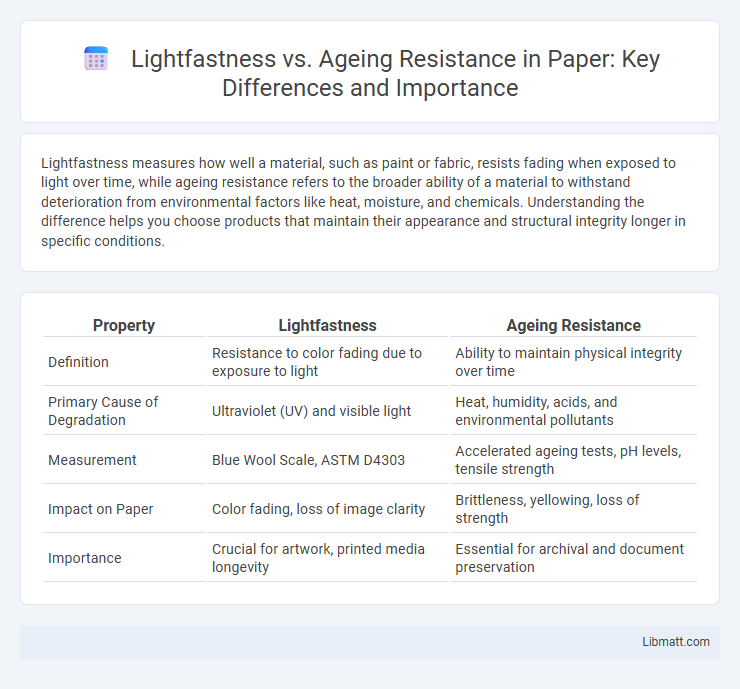Lightfastness measures how well a material, such as paint or fabric, resists fading when exposed to light over time, while ageing resistance refers to the broader ability of a material to withstand deterioration from environmental factors like heat, moisture, and chemicals. Understanding the difference helps you choose products that maintain their appearance and structural integrity longer in specific conditions.
Table of Comparison
| Property | Lightfastness | Ageing Resistance |
|---|---|---|
| Definition | Resistance to color fading due to exposure to light | Ability to maintain physical integrity over time |
| Primary Cause of Degradation | Ultraviolet (UV) and visible light | Heat, humidity, acids, and environmental pollutants |
| Measurement | Blue Wool Scale, ASTM D4303 | Accelerated ageing tests, pH levels, tensile strength |
| Impact on Paper | Color fading, loss of image clarity | Brittleness, yellowing, loss of strength |
| Importance | Crucial for artwork, printed media longevity | Essential for archival and document preservation |
Understanding Lightfastness: Definition and Importance
Lightfastness refers to the ability of pigments and dyes to resist fading when exposed to light, ensuring the longevity of colors in artworks, textiles, and printed materials. This property is crucial for maintaining the original vibrancy and accuracy of colors over time, especially under sunlight or artificial lighting. Understanding lightfastness helps you select materials with high durability, preserving your creative or commercial work against discoloration and degradation.
What is Ageing Resistance in Materials?
Ageing resistance in materials refers to the ability to maintain physical and chemical properties over time despite exposure to environmental factors such as UV light, heat, moisture, and oxygen. It is a critical indicator of durability, preventing degradation processes like discoloration, embrittlement, or loss of mechanical strength. High ageing resistance ensures prolonged functionality and aesthetic stability, essential for coatings, polymers, and composite materials in demanding applications.
Key Differences Between Lightfastness and Ageing Resistance
Lightfastness measures how well a material, such as pigments or dyes, resists fading when exposed to light, primarily ultraviolet rays, over time. Ageing resistance refers to the overall durability of a material against various environmental factors, including heat, moisture, and chemical exposure, that cause degradation beyond light exposure. Understanding these key differences helps you choose products that maintain appearance and structural integrity in different conditions.
Factors Influencing Lightfastness
Factors influencing lightfastness include the chemical composition of pigments, exposure to UV radiation, and the presence of protective coatings. Environmental conditions such as humidity and temperature fluctuations also play a crucial role in the degradation process. Your choice of materials can enhance the longevity of colors by minimizing fading and preserving vibrancy over time.
Elements Impacting Ageing Resistance
Ageing resistance in materials is significantly influenced by environmental conditions such as UV radiation, temperature fluctuations, and moisture exposure, which accelerate degradation processes. The presence of antioxidants, stabilizers, and protective coatings enhances the material's ability to withstand oxidative and photochemical damage over time. Chemical composition, including polymer structure and additives, plays a crucial role in determining the durability and lifetime performance against ageing factors.
Testing Methods for Lightfastness
Testing methods for lightfastness primarily include accelerated weathering tests such as Xenon arc and UV fluorescence exposure, which simulate natural sunlight to evaluate color stability over time. Standardized protocols like ASTM D4303 and ISO 105-B02 ensure consistent measurement of pigment and dye fading by controlling light intensity, temperature, and humidity during tests. These methods provide critical data for predicting material aging resistance and long-term durability in various environmental conditions.
Evaluating Ageing Resistance in Materials
Evaluating ageing resistance in materials involves assessing their ability to maintain structural integrity and appearance under environmental stressors such as heat, moisture, and UV radiation. Lightfastness specifically measures a material's resistance to color fading when exposed to light, particularly ultraviolet radiation. High ageing resistance ensures prolonged durability and performance, while superior lightfastness guarantees color stability in applications like textiles, coatings, and plastics.
Lightfastness in Art, Textiles, and Printing
Lightfastness measures a material's resistance to fading when exposed to light, crucial for maintaining vibrancy in art, textiles, and printing applications. High lightfastness ratings ensure that pigments and dyes retain their color integrity over time, preserving the original appearance of artworks, fabric designs, and printed materials. Your choice of lightfast materials directly impacts the longevity and quality of visual elements in various creative and commercial projects.
Enhancing Ageing Resistance: Tips and Techniques
Enhancing ageing resistance involves selecting materials with high lightfastness ratings, such as pigments certified under ASTM D4303, which ensures minimal color fading over time. Incorporating UV-resistant coatings and sealants further protects surfaces from photodegradation and environmental damage. Regular maintenance, including controlled exposure to light and humidity levels, significantly extends the durability and appearance of artworks and materials.
Choosing Materials: Balancing Lightfastness and Ageing Resistance
Choosing materials for your project requires balancing lightfastness and ageing resistance to ensure long-lasting color stability and structural integrity. High lightfastness pigments prevent fading under UV exposure, while strong ageing resistance protects against environmental factors like humidity and temperature fluctuations. Prioritizing both properties guarantees materials maintain their appearance and durability over time.
Lightfastness vs ageing resistance Infographic

 libmatt.com
libmatt.com